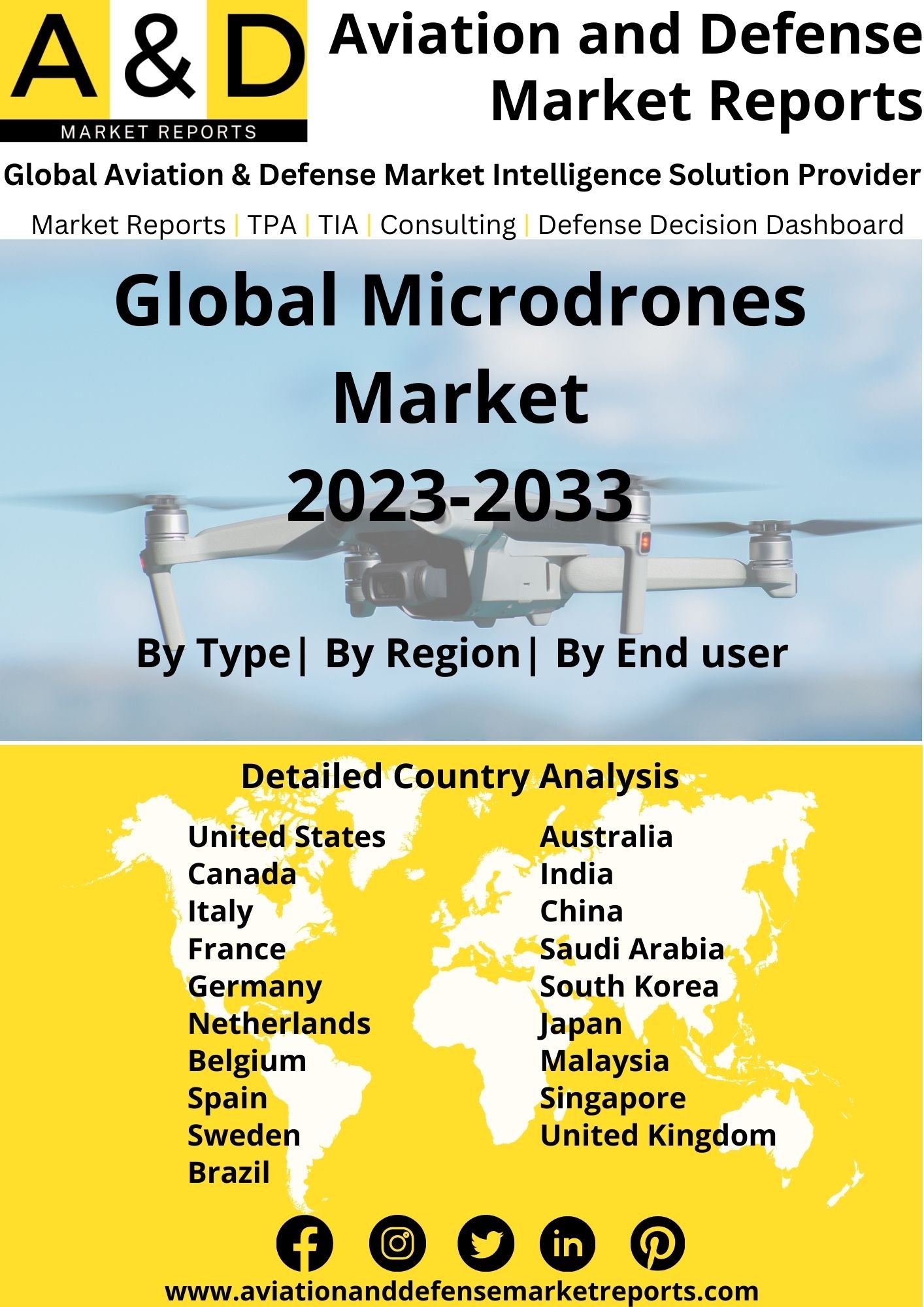Description
Microdrones Market
Microdrones market are small-scale unmanned aerial vehicles (UAVs) that can carry sensors and cameras as payloads. These tiny drones give us a birds-eye perspective of the landscape, which is useful for a variety of tasks like disaster management, surveillance, and environmental monitoring. These small unmanned aerial vehicles offer quick navigation and a superior communication range. Micro-drones market trends can be used for remote surveillance of dangerous situations, therefore situations that stay inaccessible during usual surveillance operations can be covered using microdrones. They may only weigh 2 kg or less, making them light enough to be carried and launched.
Microdrones are also known to modernise outdated methods of operation. With its accurate measuring, low cost, time-saving, and all-weather solutions, microdrone technology is revolutionising surveying procedures. For aerial inspection and surveying, microdrones are dependable and secure. They can be used to inspect buildings, railways, electricity lines, wind turbines, solar panels, and other important infrastructure. They have cutting-edge electronics and sensors and are compact, autonomous, and risk-free.
Major factors driving Microdrones Market Growth
Due to their low weight and small size microdrones can reach inaccessible places this in turn supports the expansion of microdrones market size thus predicting a positive market forecast. A UAV can collect data more quickly in emergency scenarios where gathering and processing satellite photos can take some time. Moreover, the growth in investment within the unmanned systems microdrones market is anticipated to drive the growth associated with the use of microdrones. The increased proliferation of automation-based technologies and the wave of Industry 4.0 has led to increased adoption and shift towards technologies like unmanned systems. Several laborious manned operations are now being replaced by automated technologies that hereby increase both productivities as well as efficiency associated with tasks.
During surveillance operations in specific, it is noted that increased accuracy plays an integral role in terms of the determination of forthcoming battle strategies or results of a research-based study. Thus, as per microdrones market analysis, the high rate of microdrones market growth penetration of unmanned systems is hereby expected to drive the demand margins for this microdrones market hence supporting the expansion of microdrones 4.0 microdrones market size.
Trends influencing the Micro drones Market Size
The expansion of indigenous programmes is one of the key factors that is anticipated to increase the use of microdrones in world microdrones markets forecast as per microdrones market analysis. India is notable for making progress in this field with its “Make in India” initiative. According to the multiplier effect, it is well known that the implementation of domestic programmes increases the likelihood of direct and indirect employment within a nation. This is anticipated to be a significant microdrones market driver for domestic manufacturing of equipment related to aerospace and defence since the purchasing power of the citizens’ increases which is hereafter expected to increase the GDP contribution of the defence sector.
For instance, microdrones market analysis states that the first indigenous, comprehensive Naval Anti Drone System (NADS), with both hard kill and soft kill capabilities, will be supplied to the Indian Navy by Navratna Defence PSU Bharat Limited (BEL) in New Delhi on August 31, 2021.
Micro drones Market Forecast & Dynamics
The primary element that is expected to speed up the expansion of the purchase of microdrones in APAC is reported to be the geopolitical disputes between the countries of China, Pakistan and India. India plans to improve its border security in order to improve the security offered by the nation to its citizens. As of 2021, it was noted that the Indian army was working towards inducting roughly 1000 quadcopters across the India-China and the India-Pakistan border in order to increase their surveillance capabilities. These drone models were to be inducted as a part of the Buy Indian Category for urgent operations.
The increasing defence budget is another significant trend that is anticipated to have an impact on the overall defence procurement of countries in the global microdrones markets analysis. However, the rising inflation may serve as a significant barrier to the same. Microdrones market analysis suggests that the aerospace and military industry may benefit from the probable rise in staff retention brought on by the likely increase in pay as a result of rising inflation. It is also observed that a rise in defence spending may ultimately lead to a reduction in overall defence spending.
Microdrones Market Analysis for Recent Developments
The use of technologies like additive manufacturing is noted to be one of the key factors that are poised to drive the growth associated with the microdrones 4.0 segment. The use of this technology is poised to redefine the design and integration process deployed across overall military manufacturing. Moreover, the use of sustainable materials and other material science engineering laurels predict the use of new and enhanced substances that can potentially reduce the weight associated with drones. Hence improving key performance characteristics like mobility and agility.
Under a nearly $94 million agreement signed by Washington with producer Teledyne FLIR Defense, the US Army will receive significant reinforcements of tactical Black Hornet micro drones to its current fleet, as well as an unspecified number of the tiny reconnaissance UAVs heading to Ukraine. This agreement with the US Army follows similar agreements Teledyne FLIR Defense has made with Norway in the last year. These include a $48 million transaction in 2022 and a second agreement this month with an unspecified value. According to the latter, the 300 Black Hornets Ukraine received from Oslo last year will be nearly tripled with the arrival of new drones. FLIR Teledyne According to Defense, its new five-year agreement with the Department of Defense covers its current version of Black Hornet 3 drones, which reportedly cost $195,000 per unit, as well as controllers, spare parts, and training. The new UAVs will increase the number and technological capabilities of an earlier iteration of the craft acquired by the US Army in a 2018 deal. Teledyne FLIR’s Black Hornets weigh only 33 grams (less than 0.1 pounds), measure 168 millimeters (less than seven inches), and fly at speeds of up to 10 meters per second for up to 25 minutes. The drones are equipped with three front-facing sensors and will transmit real-time visual and thermal video to US Army operators during both piloted and pre-programmed flight.
Key Companies







